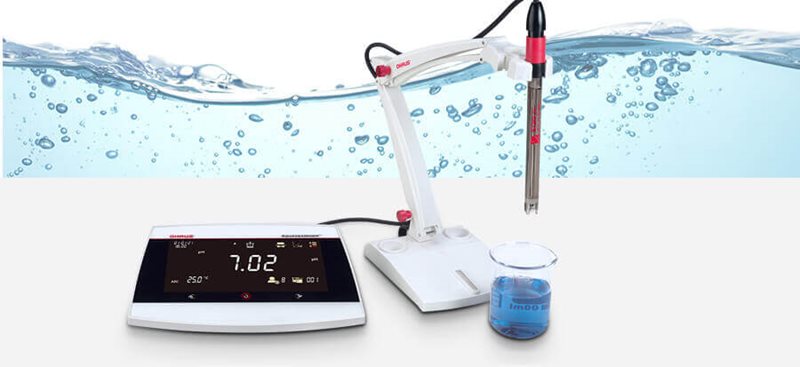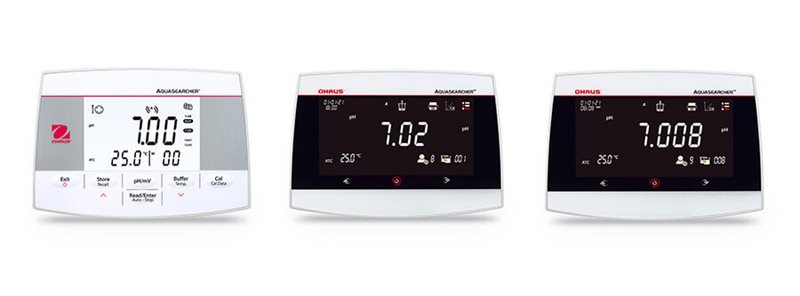
Table of Contents
Goal
Introduction
Quick Facts: Pure Water
Optimize your pH Test Results
Choosing a pH Electrode
Sampling Considerations
Calibrating your pH electrode
Handling your pH electrode
How to Test pH of Pure Water and Other Low Conductivity Waters
Summary
Contact Us
The following application note describes the challenges and recommendations when measuring pH in purified water and other low conductivity waters.
Measuring pH in pure water may seem simple in theory. For example, pure water should be neutral-pH 7.0, and there should be no interferences.
Measuring the pH of pure water is challenging because the pH electrode response tends to drift and may be slow, non-reproducible and inaccurate. Measurements in these samples are more difficult because of the low conductivity of the sample, differences between the low ionic strength solutions and normal ionic strength buffers, changes in the liquid junction potential and the absorption of carbon dioxide into the sample. Since pure water solutions have a low conductivity, the solution will tend to act as an “antenna” and the electrode response can be noisy.
By understanding the challenges associated with measuring pH in pure water and other low conductivity liquids, you can overcome them and ensure that your pH measurements are reliable and repeatable.
Low conductivity water is described by ASTM D5464 as water with a conductivity of < 100 μS/cm.
The pH of high purity water is generally in the range of 5.5 to 7.5, depending on the level of carbon dioxide (CO2) in the water.
Purified water that has very few ionic species is said to be low in alkalinity, ionic strength, or have low conductivity/high resistivity.
Pure water samples include distilled water, deionized water, some process waters, well water, some surface waters, some treated effluents, boiler feed water, and rain water.
The three most common challenges when testing pH in pure water and other low conductivity waters are:
- Electrode Drift
Low conductivity water is a high resistance sample. This may lead to noisy readings and signal drift.
- Contamination of Sample
Due to the low concentration of ions in these waters, they are also poorly buffered and so are subject to contamination (e.g. from CO2 or ammonia absorption, and/or cross contamination from other sources, during sampling, transport, storage, handling, and testing).
- Inaccurate Measurement
The large difference in ionic strength between the electrode filling solution inside and the sample outside the electrode may lead to significant junction potentials. This can affect accuracy, cause long stabilization times, and lead to poor precision.
There are several different factors that can be optimized to provide high quality pH test results in pure water and other low conductivity waters. These factors include:
- Choosing the right pH electrode
- Sampling considerations
- Calibrating your pH electrode
- Proper Handling of your pH Electrode

There are many different types of electrodes available for pH measurement. When selecting your electrode, it is important to consider the electrode features and its compatibility with the sample being measured. A low resistance junction works best when measuring pure water samples. Avoid a saturated silver electrode filling solution - a precipitate can form on contact with pure water, which may lead to clogging and high resistance in the junction.
Use a well-shielded electrode and a high-impedance pH meter to reduce signal noise.
pH electrodes are the best performers.
Since pH is temperature sensitive, use a triode or an automatic temperature correction (ATC) probe to monitor sample temperature and automatically adjust electrode slope response.
- Handle low conductivity water samples carefully to minimize air and CO2 absorption. Using glass containers is recommended, since air can diffuse through plastic.
- For transportation and storage of samples, fill container with enough sample so there is no headspace.
- Test the samples as soon as possible after collection to minimize temperature changes, sample aeration, and contact time with the sample container.
- Make sure that all containers and equipment are triple-rinsed with pure water before use to avoid cross- contamination, which can arise from a variety of sources.
Calibration of a pH electrode in high ionic strength buffers will increase the time required for stabilization when measuring a low ionic strength sample. In addition, the possibility of sample contamination will be increased. For most precise measurements, buffers and samples should have a similar ionic strength. Best results are obtained when the calibration standards and samples are within 2°C of each other. Use an ATC or triode to monitor temperatures. If sample and calibration standards cannot be at the same temperature, measure the pH at the temperature as found, and use an ATC or triode to measure temperature and adjust the slope accordingly. When documenting the results, report the pH value and the temperature reading together.
Rinse well after electrode calibration to avoid cross-contamination of your samples. It takes only a tiny amount of buffer to dramatically shift your pure water pH results. Use the cleanest possible water for rinsing.
Since pure water can leach ions from the pH bulb, store the pH electrode in electrode storage solution to restore the bulb surface composition. If response becomes sluggish, clean the pH electrode to refresh the pH bulb and/or the junction.
Option 1
Use best practice rinsing and testing techniques
- For each sample tested, prepare one test portion and one or more rinse portions. Immerse and gently agitate the pH electrode in the rinse portion(s) before placing into the test portion.
Rinsing will reduce cross contamination, adjust the electrode to the temperature of the sample, and rinse and condition the junction to the ionic strength of the sample. The same rinsing technique may be used with the calibration buffer standards.
- Stir the sample gently to speed up the electrode response. Stirring may continue throughout, as long as air is not being incorporated into the sample by the stirring action.
- Use a continuous read option and allow plenty of time for the electrode to respond completely. Best precision and accuracy occur when adequate time is allowed to reach stability.
Once a typical response time has been established, consider using a timed reading to promote an adequate wait time that will achieve consistent and precise results.
- For high precision work, ASTM D1293 recommends testing successive portions of sample until the drift rate is minimal and two successive results agree within the desired criteria. See details in ASTM D1293 at www.astm.org .
Option 2
Adjust the ionic strength of the sample (e.g., USP Purified Water test protocol)
- To dramatically improve the precision and response time of the measurement, add an ionic strength adjustor to the water sample. It won’t significantly affect the pH*. By adjusting the ionic strength, the high resistivity of the sample is overcome, and the ionic strength differential between the sample and the electrode filling solution is eliminated.
- Add 0.30 mL of saturated (~3-4M) potassium chloride (KCl) solution to 100 mL of the test sample. Stir briefly and test the pH as usual.
*For example, adding KCl at 0.01M may shift pH by +0.02 pH. (Metcalf, Peck, and Arent,
Analyst, July 1990, Vol 115, 899).
It can be quite difficult and often frustrating to obtain reproducible pH values in samples with low-ionic strength. By employing some best practices and following the recommendations outlined in this application note, you can increase measurement accuracy, reduce electrode drift and prevent sample contamination with your pH measurements.
View OHAUS' line of Water Analysis Meters and Electrodes
